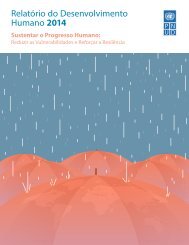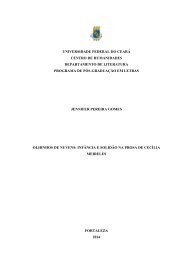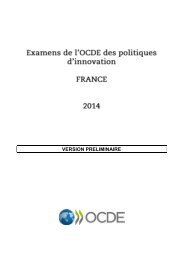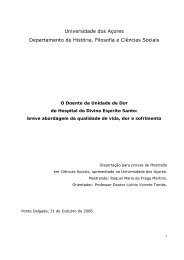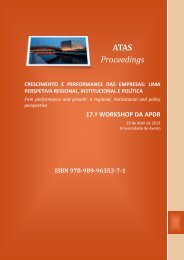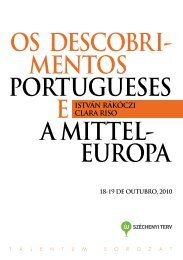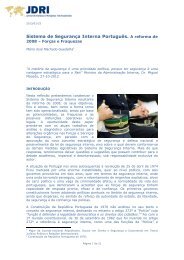1POTXAdSn
1POTXAdSn
1POTXAdSn
Create successful ePaper yourself
Turn your PDF publications into a flip-book with our unique Google optimized e-Paper software.
Azores could result, at least partially, from a weak<br />
knowledge of most of the taxa, since there is a clear<br />
tendency for endemism in better studied groups (e.g.<br />
molluscs and amphipods) (see Lopes et al. 1993;<br />
Ávila 2005).<br />
Based on the analysis of the literature used to<br />
compile the present inventory, we find a scarce number<br />
of publications per decade, between the first reports on<br />
the XIX century and the onset of the works resulting<br />
from the establishment of the University of the Azores,<br />
in the beginning of the 70s. More recently, the need<br />
to implement the marine and coastal protected areas<br />
classification has demanded a great investment on the<br />
marine biodiversity inventory in several areas of the<br />
archipelago. It is interesting to notice a geographical<br />
overlap between areas for which geo-referenced<br />
information is available and the location of the<br />
protected areas. So, paradoxically, in recent years, the<br />
legal demands for planning and management issues<br />
were the driving force for improving the knowledge<br />
on marine coastal biodiversity and its distribution in<br />
the Azores.<br />
Whereas, a complete inventory of marine species<br />
for the Canary archipelago has already been<br />
accomplished, the Azores inventory of marine species<br />
is still a work in progress. However, it should be said<br />
that the Azores is the first region in Portugal to issue<br />
a regional inventory of marine fauna since the first<br />
reports of Prince Albert of Monaco. Such fact should<br />
be mentioned as an excellent way to proudly celebrate<br />
the International Year of Biodiversity.<br />
Thus, we expect that the inventory now published<br />
can serve as inspiration for more and better investment<br />
in basic research, in general, and in taxonomy and<br />
systematics, in particular. Traditional taxonomy has<br />
been erroneously considered an obsolete discipline and<br />
consequently has been relegated to the background,<br />
especially in what concerns public and private<br />
funding. However, taxonomy is essential for applied<br />
research in several scientific areas that, ultimately,<br />
will be compromised. In fact, as the great systematists<br />
are vanishing it is necessary to recognize the need to<br />
train a new generation of researchers in taxonomy,<br />
valuing the knowledge accumulated from decades of<br />
hard and meticulous work in combination with today´s<br />
technological capabilities.<br />
295<br />
se apresentam em listas resultantes de um levantamento<br />
exaustivo, mas acreditamos que um estudo taxonómico<br />
mais aprofundado revelará mais registos e quiçá novos<br />
endemismos. Nos Açores, podemos no entanto salientar<br />
a família Rissoidae (Gastropoda) como aquela que, talvez<br />
por estar mais bem estudada, revela o maior número<br />
de endemismos. Assim, é possível que a baixa taxa de<br />
endemismos marinhos seja, pelo menos em parte, um<br />
reflexo do baixo conhecimento da maioria dos taxa, já<br />
que nos moluscos e anfípodes existem claras tendências<br />
de endemismos (ver Lopes et al. 1993; Ávila 2005).<br />
Da análise das obras utilizadas para a presente inventariação,<br />
podemos afirmar que houve um hiato,<br />
pontuado por muito poucas publicações por década,<br />
entre os primeiros registos do século XIX e o início dos<br />
trabalhos impulsionados pela criação da Universidade<br />
dos Açores, na década de 1970. Mais recentemente, a<br />
necessidade de proceder à classificação de reservas marinhas<br />
e costeiras levou a um maior esforço de inventariação,<br />
realizado em várias zonas costeiras e marinhas<br />
das diferentes ilhas. É aliás interessante verificar uma<br />
coincidência geográfica entre as zonas para as quais há<br />
informação geo-referenciada e a localização das áreas<br />
protegidas. Assim, paradoxalmente, podemos afirmar<br />
que em anos recentes têm sido as necessidades legislativas,<br />
impostas à gestão e planeamento, a força motriz<br />
para um maior conhecimento da distribuição da biodiversidade<br />
no arquipélago dos Açores.<br />
E se, nas Canárias, a inventariação completa das<br />
espécies marinhas é um facto, a região dos Açores<br />
é pioneira em Portugal na edição da compilação da<br />
sua fauna marinha, sendo esta uma excelente forma<br />
da Região celebrar o Ano Europeu da Biodiversidade<br />
editando o primeiro inventário da sua fauna costeira<br />
desde o legado deixado pelo príncipe Alberto do Mónaco,<br />
constituído pela obra notável dos relatórios das<br />
suas campanhas nos Açores.<br />
Assim, esperamos que o inventário que agora se<br />
publica possa servir de mote e de inspiração para mais<br />
e melhores aplicações do investimento na investigação<br />
fundamental em geral e na taxonomia e sistemática em<br />
particular. Sendo considerada obsoleta, a taxonomia<br />
tem sido relegada erroneamente para segundo plano,<br />
sobretudo no que diz respeito ao financiamento (público<br />
e privado). No entanto, é nela que assenta a investigação<br />
aplicada que, no limite, ficará comprometida.





